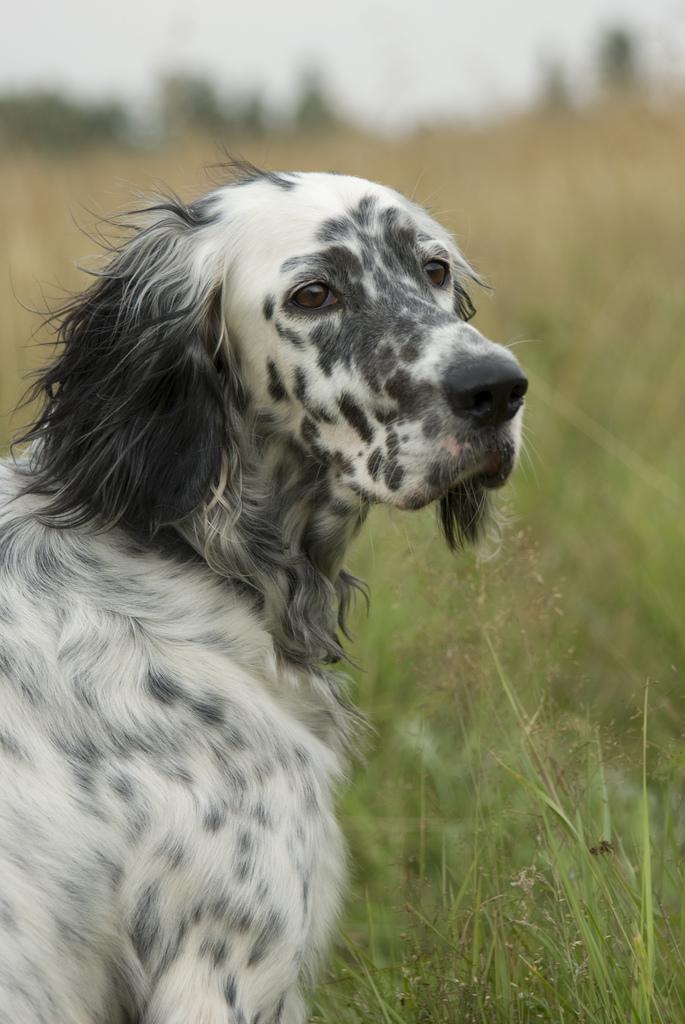The English Setter has a background as a hunting dog and continues to make excellent companions for hunters today. But he is also a good companion in other respects because he is social, playful, and loving towards his people.
Background

The English Setter is a noble and beautiful breed that has a history stretching back centuries. The term “English Setter” was in use as early as the 18th century, but the breed only began to develop and take shape in the mid-19th century. As the name suggests, the English Setter originated in England. Apparently the Englishman Edward Laverack played an important role in the development of the breed. Through a careful selection of breeding dogs, he developed his own breed of setter, referred to as the Laverack Setter. The English Setter is based on this breed. The English Setter was bred to be a hunting dog that enjoys being with its hunting family, both in the field and in the woods. His main tasks were tracking down and showing wild birds such as pheasant, rapeseed and ptarmigan, but also wild boar.
Temperament
The English Setter is a gentle and social dog that needs a lot of human contact. But perhaps more importantly, he needs a lot of exercise. If you take care of the needs of the English Setter, he is also a calm and affectionate house dog.
The English Setter is loyal to his family members. With his tolerance and patience, he usually goes well with families with children or other pets.
What is undisputed is that the setter is best suited to an owner who hunts or has a large yard. But with plenty of exercise, the setter will also be happy in other environments.
Level of activity

If you are not an active person, you should choose another breed of dog. Because the English Setter needs a lot of exercise and exercise. In addition to regular walks, you should offer your dog physically challenging activities.
Of course, hunting or hunting training is perfect if you have the opportunity. But as long as you can find other ways to keep your English Setter active and intellectually challenged, you’re safe. The breed is a real star in canine sports like agility and rallying.
Grooming
Although the breed has a long coat, grooming is not very demanding. Brush the fur as needed and trim the hair around the paws in winter to prevent clumps of snow from getting stuck.
Height and weight
The English Setter is a medium-sized dog with a strong and resilient body. The size is 65-68 cm for males and 61-65 cm for females. The weight is between 20 and 36 kg.
Color

The English Setter has a white coat with spots of various colors, mostly black or tan.
Peculiarities of the breed
Breeders of the breed have different goals for the dog. While most focus on hunting characteristics, others are more interested in looks. So if you’re thinking about getting an English Setter, you’ll need to decide which lineage will suit you better.
As said, for the English Setter to thrive it needs an active owner, ideally with the ability to hunt (if you choose this line).
Hereditary diseases
The English Setter is generally a very healthy breed, but hip dysplasia (HD) and neuronal ceroid lipofuscinosis (NCLs) do occur.
Food
The English Setter tends to gain weight quickly. So keep an eye on the amount of food and his physique.
The amount of food your English Setter should be fed should be tailored to their characteristics and physical condition. Factors that are important are age, size, activity level, and metabolism. Consult your veterinarian if anything is unclear about your dog’s feeding routine.
Training
He works well with people, but also on his own. Because when hunting, it happened that the setter ran further away from the hunter and followed his instincts. Train your English Setter consistently and with positive reinforcement and you will get on very well together.
The breed doesn’t bark a lot, but because the dogs are very alert, they make good watchdogs. The setter will likely bark to alert you that someone is approaching the family territory. But as soon as he is introduced to unfamiliar people, he is very friendly.
Five facts about the English Setter

- The English Setter was developed in England for hunting, with the primary job of tracking and pointing birds.
- His level of activity is high and the breed needs a lot of exercises to stay healthy and happy.
- The setter is social and needs a lot of company.
- The English Setter comes in white with spots of various colors.
- Breeders focus on either hunting traits or appearance. Before you get an English Setter, think about which lineage is right for you.






























